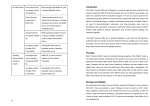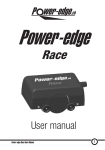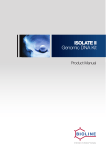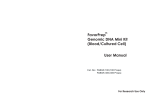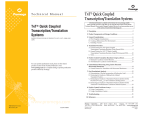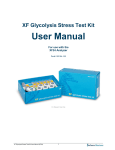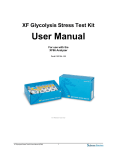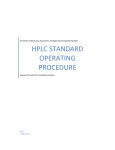Download Introduction
Transcript
Introduction The Solar® MicroElute Genomic DNA Kit provides a rapid and easy method for the isolation of genomic DNA and mitochondrial DNA from small size or volume of samples for consistent PCR and other downstream applications. This kit can be used for preparation of genomic DNA from micro-dissected tissue, cultured cells, blood, dry blood, swabs, buffy coat, serum, urine and plasma. The kit allows single or multiple, simultaneous processing of samples. There is no need for phenol/chloroform extractions, and time-consuming steps such as precipitation with isopropanol or ethanol. Principle The Solar® MicroElute Genomic DNA Kit uses the reversible binding properties of the HiBind® matrix, a new silica-based material, combined with the MicroElute column spin technology which allows smaller elution volume as little as 10μl. A specially formulated buffer system allows genomic DNA up to 40 kb to bind to the matrix. Samples are first lysed under denaturing conditions and then applied to the HiBind® Micro-spin columns to bind DNA, while cellular debris, hemoglobin, and other proteins are effectively washed away. High quality DNA is finally eluted in sterile deionized water or low salt buffer. Storage and Stability All components of the Solar® MicroElute Genomic DNA Kit, except the Protease K can be stored at 22oC-25oC and are guaranteed for at least 24 months from the date of purchase. Once reconstituted in water, Protease K must be aliquot and stored at -20oC. Under cool ambient conditions, a precipitate may form in the Buffer DL. In case of such an event, heat the bottle at 37oC to dissolve. Store Buffer DL at room temperature. Binding Capacity Each HiBind® MicroElute column can bind up to 10 μg genomic DNA. Use of more than 10 mg tissue or 5 x 106 cells is not recommended. Kit Contents Problem Product Possible Cause Suggestions No ethanol added Dilute Wash Buffer with the indicated volume to Wash Buffer of absolute ethanol before use. DH120-00 DH120-01 DH120-02 5 50 200 15 150 600 Washing Incomplete lysis Buffer DL is viscous and the sample must be Buffer DL 5 ml 35 ml 125 ml leaves due to improper votexed thoroughly. Buffer ATL 5 ml 35 ml 125 ml colored mixing with Buffer Buffer PW1 3 ml 30 ml 120 ml residue in DL. Buffer PW2 Concentrate 2 ml 20 ml 3 x 20 ml Linear Acrylamide (5mg/ml) 25μl 250μl 900μl ER Buffer 2 ml 10 ml 40 ml 200 ul 1.8 ml 7 ml 3 mg 30 mg 4 x 30 mg 1 1 1 HiBind® MicroElute Columns 2 ml Collection Tubes Protease Storage Buffer Protease K User Manual column No ethanol added Dilute Wash Buffer with the indicated volume to Wash Buffer. of absolute ethanol before use. Before Starting 1 Reconstitute Protease K with Protease Storage Buffer as follows, then aliquot and store the solution at -20̊C DH120-00: Dissolve in 150 μl Protease Storage Buffer IMPORTANT DH120-01: Dissolve in 1.50 ml Protease Storage Buffer DH120-02: Dissolve in 1.50 ml Protease Storage Buffer per tube 2 Buffer PW2 Concentrate must be diluted with absolute ethanol(96-100%) as follows: 2 DH120-00 Add 8 ml absolute ethanol (96-100%). DH120-01 Add 80 ml absolute ethanol (96-100%). DH120-02 Add 80ml absolute ethanol per bottle. 15 3 Problem Possible Cause Suggestions Low Extended Resin from the column may be present in eluate. centrifugation Avoid centrifugation at speeds higher than Acrylamide to Buffer DL to enhance DNA binding ability to during elution step. specified. The material can be removed from the the column. A 0 /A 260 28 ratio Linear Acrylamide: For purification of DNA from very small amounts of samples, such as low volume of blood (<10ul) or micro-dissected tissues, we recommend to add Linear eluate by centrifugation. Poor cell lysis due Repeat the procedure, this time making sere to to incomplete vortex the sample with Buffer DL immediately and mixing with Buffer completely. Equipment and Reagents to Be Supplied by User Absolute ethanol (96-100%) 1.5 ml or 2ml microcentrifuge tubes Water Bath or heating block preset at 60 ℃ Water Bath or heating block preset at 70 ℃ DL Microcentrifuge with rotor for 2ml tubes DTT (for processing hair and semen) Incomplete cell lysis Increase incubation time with Buffer ATL and or protein protease. Ensure that no visible pieces of tissue Tabletop centrifuge capable of 20,000 x g (13,000 x rpm) remain. Optional: Solar Homogenizer Column for collect any remaining liquid from paper ER Buffer or ddH2O pre-warmed at 70 ℃ or swab. Samples are rich in After applying to column, wash with Buffer PW1 protein. twice then with Buffer PW2. No DNA Improper mixing Mix thoroughly with Buffer DL prior to loading eluted with Buffer DL. column. Poor cell and/or Tissue sample must be cut or minced into protein lysis in Solar® Protocol for Small Size of Tissue This method allows genomic DNA isolation from up to 10 mg tissue. Yields vary depending on source. OPTIONAL: Although no mechanical homogenization of tissue is necessary, pulverizing the samples in liquid nitrogen will improve lysis and reduce incubation small pieces. Increase incubation time at 65 time. Once the liquid nitrogen has evaporated, transfer the powdered tissue to a ℃ with Buffer ATL to ensure that tissue is Buffer ATL. completely lysed. Absolute ethanol Before applying sample to column, an aliquot not added to of Buffer DL/ethanol must be added. See Buffer DL. protocol above. clean 1.5 ml tube. Add 200 μl Buffer ATL and proceed to step 2 below. 1. Mince up to 10 mg of tissue and place into a 1.5 ml microfuge tube. Add 200 μl Buffer ATL. Cut the tissue into small pieces to speed up lysis. 2. Add 20 μl Protease K solutions, vortex to mix well, and incubate at 55oC in a shaking waterbath to affect complete lysis. If no shaking water bath is available, 14 3 vortex the sample every 20-30 minutes. Lysis time depends on amount and type 14. To elute DNA from the column, centrifuge at 20,000 x g for 1 min. of tissue, but is usually under 3 hours. One can allow lysis to proceed overnight. 3. Centrifuge at 20,000 x g for 2 minutes to remove any undigested particles from cell lysates. 4. OPTIONAL: Certain tissues such as liver have high levels of RNA which will be co-purified with DNA using this kit. While it will not interfere with PCR, the RNA may be removed at this point. Add 5 μl (assuming a sample size of 10 mg) RNase A (25 mg/ml) and incubate at room temperature for 2 minutes. Proceed with the Troubleshooting Guide Problem Possible Cause Suggestions Clogged Incomplete lysis Extend incubation time of lysis with Buffer Column ATL and protease. Add the correct volume of Buffer DL and incubate for specified time at tissue protocol. 5. 70oC. It may be necessary to extend incubation time by 10 min. Add 220 μl Buffer DL and vortex to mix well. Incubate at 70oC for 10 minutes. If Sample too large Linear Acrylamide is needed, add 4μl of Linear Acrylamide to 220μl Buffer DL. If using more than 30 mg tissue, increase volumes of Protease K or Proteinase K, 6. Add 220 μl absolute ethanol and mix thoroughly by vortexing for 15s at maxi Buffer ATL, Buffer DL, and ethanol. Pass speed. Centrifuge briefly to bring down any liquid from inside of lid. aliquots of lysate through one column successively. 7. Assemble a HiBind® MicroElute column in a 2 ml collection tube (provided). Transfer the entire solution from Step 6 into the column including any precipitate that may have formed. Close the lid and centrifuge at 8,000 x g for 1 min to bind DNA. Discard the collection tube and flow-through liquid. Low DNA yield 8. Place the column into a new collection tube (supplied). Add 500μl of Buffer PW1 in Sample too Divide sample into multiple tubes, adjust viscous volume to 250 μl with 10 mM Tris-HCl. Clogged column See above Poor elution Repeat elution or increase elution volume. Incubation of column at 70oC for 5 min with the column. Close the lid and centrifuge at 8000 x g for 1 minute. Discard the ER Buffer may increase yields. flow-through and re-use collection tube. Improper washing 9. Place the column into the same 2 ml collection tube from step 8 and wash by pipetting in 650 μl of Buffer PW2 diluted with ethanol. Centrifuge at 8,000 x g for 1 Wash Buffer Concentrate must be diluted with absolute (100%) ethanol min. Again, dispose of collection tube and flow-through liquid. Note: Buffer PW2 Concentrate must be diluted with absolute ethanol before use. Refer to label on bottle for directions for preparation. 4 13 inside of lid. 10. 7. Using a new collection tube, wash the column with a second 650 μl of Buffer PW2 Assemble a HiBind® MicroElute column in a 2 ml collection tube (provided). diluted with ethanol and centrifuge as above. Discard flow-through and re-sue the Transfer the 600μl of sample from Step 6 into the column including any precipitate collection tube. that may have formed. Close the lid and centrifuge at 8,000 x g for 1 min to bind DNA. Discard flow-through liquid and re-use the collection tube. 11. Using the same 2ml collection tube, centrifuge empty column at maximum speed (20,000 x g) for 3 min to dry the HiBind® membrane. This step is crucial for 8. ensuring optimal elution in the following step. Place the HiBind® MicroElute column into the same collection tube from step 7 and transfer the remaining lysate from step 6 into the column. Centrifuge at 8000 x g for 1 minute. Discard the flow-through and collection tube. 12. Place the column into a nuclease-free 1.5 ml microfuge tube (Not supplied) and add 10-50 μl of preheated (70oC) ER Buffer or water onto the center of membrane. 9. Place the column into a new collection tube (supplied). Add 500μl of Buffer PW1 in Allow tubes to sit for 3 min at room temperature. the column. Close the lid and centrifuge at 8000 x g for 1 minute. Discard the flow-through and collection tube. 10. 13. To elute DNA from the column, centrifuge at 20,000 x g for 1 min. Place the column into a new 2 ml tube (supplied) and wash by pipetting 650 μl of Note: Incubation at 70oC rather than at room temperature will give a modest Buffer PW2 diluted with ethanol. Centrifuge at 8,000 x g for 1 min. Discard the increase in DNA yield per elution. Alternatively the second elution may be flow-through and re-use the collection tube. performed using the first eluate or using the second 10-100μl of preheated ER Buffer or water. Note: Buffer PW2 must be diluted with absolute ethanol before use. Refer to label on bottle for directions for preparation. 11. Using the same collection tube from step 10, wash the column with a second 650 μl of Buffer PW2 diluted with ethanol and centrifuge as above. Discard flow-through and re-use the collection tube. 12. Using the same 2ml collection tube, centrifuge empty column at maximum speed (20,000 x g) for 3 min to dry the HiBind® membrane. This step is crucial for Solar® Protocol For Smaller volume of Blood, serum or body fluids This protocol is designed for the rapid isolation of DNA from 1-100μl of blood treated with EDTA, citrate, or heparin-based anticoagulants. This method can be used for preparation of genomic DNA from serum, saliva, urine, buffy coat, serum, and plasma. 1. before process) into a 1.5 ml microfuge tube. ensuring optimal elution in the following step. 13. Place the column into a sterile 1.5 ml microfuge tube and add 10-50μl of preheated (70oC) ER Buffer or water onto the center of the membrane. Allow tubes to sit for 3 min at room temperature. 12 Prepare 1-100μl samples (sample must be equilibrated to room temperature 2. Adjust the sample volume to 100μl with PBS Buffer. 3. Add 20 μl of Protease solution and mix well by vortexing. 5 4. ensuring optimal elution in the following step. Add 120 μl Buffer DL and vortex to mix. Incubate at 70oC for 10 minutes. If the blood volume is less than 10μl, 4μl of linear acrylamide is recommended to be added to each sample. 15. Place the column into a sterile 1.5 ml microfuge tube and add 10-50μl of preheated (70oC) ER Buffer or water onto the center of the membrane. Allow 5. Add 120 μl absolute ethanol and mix thoroughly by vortexing for 15s at maxi tubes to sit for 3 min at room temperature. speed. Bring down any liquid drop from inside of lid by brief centrifugation. 16. 6. Assemble a HiBind MicroElute column in a 2 ml collection tube (provided). Transfer the entire solution from Step 5 into the column, including any precipitate that may have formed. Close the lid and centrifuge at 8,000 x g for 1 min to bind DNA. Discard the collection tube and flow-through liquid. 7. Place the column into a new collection tube (supplied). Add 500μl of Buffer PW1 in the column. Close the lid and centrifuge at 8000 x g for 1 minute. Discard the flow-through and re-use collection tube. 8. Protocol for Forensic samples This protocol is designed for isolation of genomic DNA from forensic samples such as hair, cigarette butts, and nail clippings, material stained with blood, saliva, or semen stints. 1. dispose of collection tube and flow-through liquid. stints, add 20μl of DTT for each sample. 2. incubation by vortexing. 3. diluted with ethanol and centrifuge as above. Discard flow-through and re-use the 10. Using the same 2ml collection tube, centrifuge empty column at maximum speed (20,000 x g) for 3 min to dry the HiBind membrane. This step is crucial for ensuring 4. Place the column into a sterile 1.5 ml microfuge tube and add 10-50μl of preheated (70oC) ER Buffer or water onto the center of the membrane. Allow 6 Add 320 μl Buffer DL, close the lid and mix thoroughly by vortexing for 20 seconds. If only one punch card is processed, add 4μl of Linear Acrylamide to the sample. 5. Place the tube in a heating block or waterbath preset at 70̊C. Incubate for 10 minutes. Vortex the tube 10 seconds few times during incubation. optimal elution in the following step. 11. Centrifuge the tube to spin down any liquid drop from inside of the lid and any material that is not lysed. Using a new collection tube, wash the column with a second 650 μl of Buffer PW2 collection tube. Add 20μl of Protease K solution to each sample. Incubate sample at 60oC for 45-60 minutes or over night if necessary. Mix the samples several times during Note: Buffer PW2 Concentrate must be diluted with absolute ethanol before use. Refer to label on bottle for directions for preparation. Cut the sample to small pieces and place into a 2 ml microcentrifuge tube. Add 300μl of Buffer ATL into the tube, mix thoroughly by vortexing. If process semen Place the column into the same 2 ml tube (supplied) and wash by pipetting 650 μl of Buffer PW2 diluted with ethanol. Centrifuge at 8,000 x g for 1 min. Again, 9. To elute DNA from the column, centrifuge at 20,000 x g for 1 min. 6. Centrifuge at 20,000 x g for 5 minutes. Transfer the supernatant to a new 2 ml microcentrifuge tube. Add 0.5 volumes of absolute ethanol and mix thoroughly by vortexing for 20s at maxi speed. Centrifuge briefly to bring down any liquid from 11 8. Add 620 μl absolute ethanol and mix thoroughly by vortexing for 20s at maxi speed. Centrifuge briefly to bring down any liquid from inside of lid. 9. that may have formed. Close the lid and centrifuge at 8,000 x g for 1 min to bind DNA. Discard flow-through liquid and re-use the collection tube. Place the HiBind® MicroElute column into the same collection tube from step 9 and repeat step 9 until all of the remaining lysate from step 8 has passed through the HiBind® MicroElute column. Discard the flow-through and collection tube. Note: For maximum yield, Collection any remaining liquid from swab, transfer all swab into a Homogenizer Column (not supplied) and centrifuge at 20,000 x g for 2 minutes to collect remaining lysates. Homogenizer column can be purchased separately from Solar Bio-Tek (Product No. HCR-001 an HCR-003). 11. 12. Place the column into a new collection tube (supplied). Add 500μl of Buffer PW1 in the column. Close the lid and centrifuge at 8000 x g for 1 minute. Discard the Solar® Protocol for Dried blood, body fluids, and Sperm Spots Dried blood, body fluids, and sperm samples on filter paper can be processed using the following method. We recommend using Specimen Paper for spotting blood, as this unique filter paper disintegrates when incubated in aqueous buffers, allowing for the efficient recovery of DNA. This kit can also be used for samples collected using other specimen collection papers Before starting: Bring frozen samples and Protease K solution to room temperature; preheat an aliquot of ER Buffer (approximately 0.5 ml per sample) at 70oC. Procedure: 1. Note: Use 1-3 punched circles (3mm diameter) for each DNA isolation. Place the column into a new 2 ml tube (supplied) and wash by pipetting 650 μl of Buffer PW2 diluted with ethanol. Centrifuge at 8,000 x g for 1 min. Discard flow-through liquid and re-use the collection tube. 2. 13. Mix the samples several times during incubation by vortexing. flow-through and re-use the collection tube. 14. Briefly centrifuge the centrifuge tube to bring down any liquid drop from inside of the lid. 4. Add 220 μl Buffer DL, close the lid and mix thoroughly by votexing 20s at maxi speed. If only one punch card is processed, add 1μl of Linear Acrylamide to the sample. Using the same 2ml collection tube, centrifuge empty column at maximum speed (20,000 x g) for 3 min to dry the HiBind® membrane. This step is crucial for 10 3. Using the same collection tube from step 12, wash the column with a second 650 μl of Buffer PW2 diluted with ethanol and centrifuge as above. Discard Add 200 μl Buffer ATL to 1-3 of 3 mm punched filter paper circle. Follow by addition of 20 μl Protease K solution. Incubate mixture at 60oC for 45-60 minutes. Note: Buffer PW2 Concentrate must be diluted with absolute ethanol before use. Refer to label on bottle for directions for preparation. Cut or punch out the blood (or other sample) spot from the filter paper. Tear or cut filter into small pieces and place into a 1.5 or 2.0ml centrifuge tube. (Not provided). flow-through and collection tube. 12. To elute DNA from the column, centrifuge at 20,000 x g for 1 min. Assemble a HiBind® MicroElute column in a 2 ml collection tube (provided). Transfer the 700μl of lysate from Step 8 into the column including any precipitate 10. tubes to sit for 3 min at room temperature. 5. Place the tube in a heating block or waterbath preset at 70℃. Incubate for 10 7 minutes. Vortex the tube 10 seconds few times during incubation. 6. 13. Place the column into a sterile 1.5 ml microfuge tube and add 10-50μl of Briefly centrifuge the centrifuge tube to bring down any liquid drop from inside of preheated (70oC) ER Buffer or water onto the center of the membrane. Allow the lid. tubes to sit for 3 min at room temperature. Note: For maximum yield, Collection any remaining liquid from paper, transfer all entire sample include paper into a Homogenizer Column (not supplied) and 14. To elute DNA from the column, centrifuge at 20,000 x g for 1 min. centrifuge at 20,000 x g for 2 minutes to collect all the lysates. Note: Incubation at 70oC rather than at room temperature will give a modest 7. Add 220 μl absolute ethanol and mix thoroughly by vortexing 20s at maxi speed. increase in DNA yield per elution. Alternatively the second elution may be Centrifuge briefly to bring down any liquid from inside of lid. performed using the first eluate or using the second 10-50μl of preheated ER Buffer or water. 8. Assemble a HiBind® MicroElute column in a 2 ml collection tube (provided). Transfer the entire lysate from Step 7 into the HiBind DNA MicroElute column including any precipitate. Close the lid and centrifuge at 8,000 x g for 2 min to bind DNA. Discard the collection tube and flow-through liquid. 9. Place the column into a new collection tube (supplied). Add 500μl of Buffer PW1 in the column. Close the lid and centrifuge at 8000 x g for 1 minute. Discard the flow-through and collection tube. 10. This protocol is designed for the isolation of genomic DNA from sperm swabs, blood swabs and buccal swabs. 1. Place the swab in a 2 ml microcentrifuge tube. 2. Add 600μl Buffer ATL and 20μl Protease solution into the tube. Mix thoroughly by vortexing for 30 seconds at maxi speed. Place the column into a new 2 ml tube (supplied) and wash by pipetting 650 μl of Buffer PW2 diluted with ethanol. Centrifuge at 8,000 x g for 1 min. Discard the flow-through and re-use the collection tube. Note: Buffer PW2 Concentrate must be diluted with absolute ethanol before use. Refer to label on bottle for directions for preparation. 11. Solar® Protocol for Isolation of Genomic DNA from Swab Using a same collection tube from step 10, wash the column with a second 650 μl 3. the sample few times during the incubation by briefly vortexing. 4. Briefly centrifuge the tube to spin down any liquid drop from inside of the lid. 5. Add 620μl Buffer DL, close the lid, and mix thoroughly by vortexing. If Linear Acrylamide is needed, add 4μl of dissolved Linear Acrylamide to 660μl Buffer DL. of Buffer PW2 diluted with ethanol and centrifuge as above. Discard flow-through and re-use the collection tube. 12. ensuring optimal elution in the following step. 8 6. Place the tube in a heating block or waterbath preset at 70̊C. Incubate for 10 minutes. Vortex the tube 10 seconds few times during incubation. Using the same 2ml collection tube, centrifuge the empty column at maximum speed (15,000 x g) for 3 min to dry the HiBind® membrane. This step is crucial for Incubate the tube in a heating block or a waterbath at 55̊C for at least 1 hour. Mix 7. Briefly centrifuge the centrifuge tube to bring down any liquid drop from inside of the lid. 9








